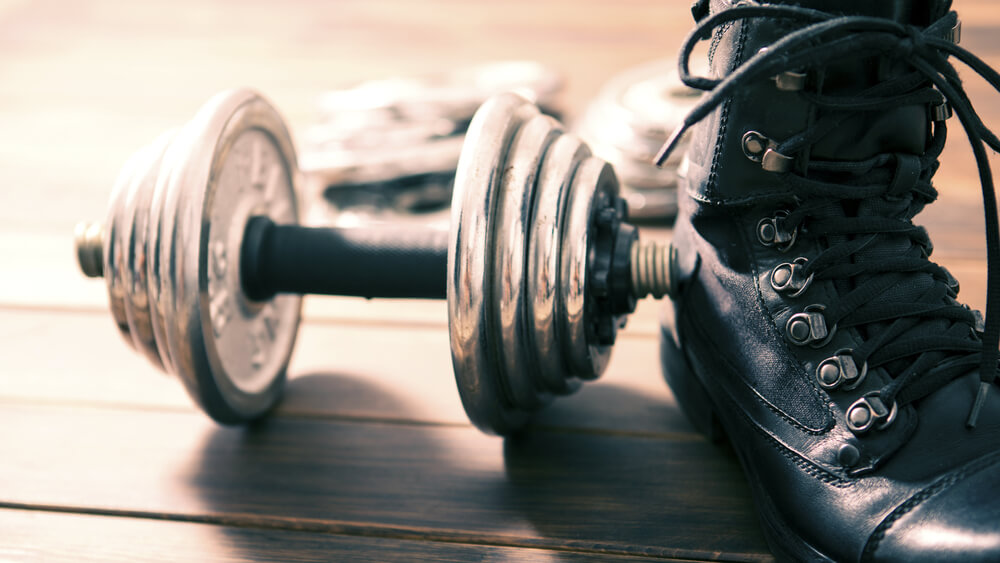Being a soldier isn’t easy. These men and women put their lives on the line to protect us all. Along the way, they go through intense training. We give you insights on how to train like them for basic training.
Ever wonder why a lot of our US soldiers are slim and clean-cut?
This appearance does not just happen overnight. A well-rounded nutrition and training program is key for your success.
In order to accomplish this, you surely need the discipline and determination to achieve your goal. Are you ready to train and eat right?
Let’s take a look at the basic training program and see if this is what will get your butt off the couch and weights in your hands.

Strength And Endurance Training Are Your Best Friends
Muscular endurance is quite important even from a functional aspect.
Why?
Simple. The reason is because you need to be able to push past fatigue to accomplish tasks. However, many people ignore this and focus only on the strength and power portion of training. Heightened muscular endurance increases your ability to train harder for longer timeframes.
Strength training is still important and very much needed by all who can perform it. This type of workout does not mean you are trying to get huge or bulky like a bodybuilder. Instead by doing strength training, you are simply moving your muscles against resistance. This will help increase muscular and bone strength.
Some people may even increase their bone density!
Both of these training styles mixed together combine to help give you a body like that of a United States soldier. These training styles combine circuit training, supersets, compound sets and High Impact Interval Training or HIIT. Lean, well defined and strong is what your goal is when doing this type of training.
Basic Training Revolves Around Circuit Training
When soldiers train they usually perform a warm up then go on a run for several miles. Afterward, or during the run, they stop to perform push-ups, sit-ups, pull-ups, mountain climbers, etc. with little to no rest in between. This is a fine example to go off of, but we want to maximize your results in lean gains.
Cardio before strength training is going to destroy your energy output for lifts. Why? By doing cardio first, you use up all your energy. As a result, you will be assigned cardio either after your workout or not at all. Don’t forget: Cardio training only burns calories during the actual act. Afterwards, you do not burn all that many calories.
Strength training, especially HIIT, will increase the amount of fat you burn and lean gains you earn. Plus, you burn calories for up to 38 hours following your workout as your muscles are in the process of struggling to recover. Cardio burns less fat and actually decreases muscle mass so you could really be looking at a case of weight loss, not fat loss.
Now, when we say circuit training, it basically means you choose three or more exercises and perform them back-to-back. No rest is given after each set. You only rest after the last exercise is performed. At that point, you rest and perform a few more rounds of all the exercises. This is a very simple and effective method for lean gains and definition.
This Is What You Need To Know About Supersets And Compound Sets
These two training methods can be implemented into a basic program or as a modified circuit workout. Both essentially use two exercises that are performed one after the other in quick succession. However, they differ by the muscle groups being targeted.
Supersets are when you perform an exercise and then follow that up right away with another exercise that targets a different muscle region. For example, you perform biceps barbell curls and then follow it up with a set of triceps pressdowns. This is beneficial because both muscles are technically used the whole time, but one more than the other in each set.
Compound sets only differ because you are targeting the same muscle groups one after another. For example, you perform flat dumbbell presses and follow it up with dumbbell chest flyes. This is beneficial for max targeting to increase strength and endurance of the muscle group being worked.
When you want to use these in a modified circuit course, you simply choose a set you like, perform it for three rounds and then choose another set you like and perform that set for three rounds as well. Choose up to five sets max for your basic training style workout.

HIIT Is Ridiculously Good For You
HIIT is one of the best workout methods you can use if your goals are lean gains and fat loss. This is essentially endurance, cardio and strength training all in one package when performed with resistance exercises. HIIT was first used as mainly a process of switching up from jogging to sprinting. But, it has spread. At this point, there are many exercises you can mix together. And, these exercises allow you to target your body as a whole.
The purpose behind HIIT is to continuously train and limit your body’s ability to get ample oxygen to your muscles as a result. This, in turn, means more calories are being burned hours after your workout as your muscles fight for oxygen stabilization and recovery. Studies show that HIIT burns more fat and increases lean muscle when compared to basic cardio such as running.
To put it simply, when it comes to HIIT you basically perform different exercises with diverse levels of intensity. For example, your first exercise can be push-ups. You follow that up with sprints. After the sprints, you perform cleans. You keep this tempo change for about 30 minutes for best results. This may sound simple, but you might find that even doing this basic example will leave you gasping for air. Don’t say we didn’t warn you.
Dynamic Warm Ups Are The Way To Go
A warm up is intended to get your muscles and joints ready for the workout that is to come. This will increase your strength output and should work to decrease your chances of preventing injuries as well.
Don’t forget: Training with stiff or tight muscles causes your performance to drop. Plus, tight muscles also tear worse under tension causing injury risks to increase significantly. That’s why stretching is vital for all people who train regardless of athletic experience.
There are several types of stretches. The two main ones are dynamic and static stretches. Static, of course, means no movements essentially. In other words, a stretch of this nature is simply pulling a muscle and holding it.
An example of this would be the cross arm stretch. You basically take a joint and place it in its full range of motion to be held for 30 seconds minimum. However, doing this as a warm up decreases your strength output by up to 30%. Static stretches tell your muscles to relax and go to sleep. That is the opposite of what a warm up is.
Dynamic stretches are better for this task. They are also called active stretches. These types of stretches involve moving your joints through continuous motions. In other words, there’s to be no holding a stretch and maintaining the position for a period of time. Active stretches help joints become lubricated. Muscle fibers should also loosen up for better performance.
When you think about it, why wouldn’t you want to spend five minutes doing this?
Some examples for dynamic stretching are high knees, butt kicks, lateral raises and chest openers. Your warm up should make you break a slight sweat.
Creating Your Basic Training Program
The following program is designed to boost your rate of fat loss and lean muscle gains. Perform each exercise with moderate weight settings to ensure you are able to complete the workout. Do not show off with large weights! Causing injury to your body for the sake of impressing others could set your training back several weeks, if not worse.
What follows is for someone who will be training three days a week. Don’t forget to allow appropriate rest periods.
Why?
Rest is important for recovery and growth. We will get into that a little bit later. You will be doing each exercise one after another if noted as a circuit workout. Supersets and compound sets only refer to two exercises back to back.
Day 1 (Strength Training Combined Sets)
Exercise Sets Reps
5-Minute Dynamic Warm Up
Superset
Flat Dumbbell Bench Press x3 x10
Dumbbell Reverse Flye x3 x10
Compound Set
Barbell Back Squat x3 x10
Alternating Dumbbell Lunge x3 x10
Seated Shoulder Press x3 x12
Bodyweight Pull-Up x3 x15
Day 2
REST
Day 3 (Circuit Training)
Exercise Sets Reps
Kettlebell Swing (Two Hand) x1 x10
Kettlebell Sumo Row x1 x10
Dumbbell Push Press x1 x10
Incline Barbell Press x1 x10
Barbell Bent Over Row x1 x10
Give yourself two minutes of rest. From there, repeat the process for a total of five rounds.
Day 4
REST
Day 5 (Circuit Training)
Exercise Sets Reps
Arnold Dumbbell Press x1 x10
Dumbbell Pullover x1 x10
Flat Dumbbell Press x1 x10
Barbell Squat x1 x10
Roman Chair Leg Raise x1 x15
Take a two-minute rest and then repeat the process a total of five rounds.
Day 6
REST
Day 7
REST
The Importance Of Rest Can’t Be Over-Hyped
Don’t get the wrong idea. Rest is not about sleeping in for 12 hours. A proper rest day means you need to be eating plenty of nutritious calories, performing stretches and, yes, getting enough sleep. The reason all of these are important is because they boost your muscles’ ability to recover efficiently.
Protein synthesis is the process where new proteins are formed and used to either replace or repair damaged proteins from training. When you train at high enough intensity, your muscle fibers become microscopically torn. This is why they can be sore and painful at times following your workout.
In order for protein synthesis to occur, you need to be consuming nutrients such as protein. All nutrients play a role in your body’s health. You also need to make sure you’re not performing activities that keep these muscles injured. Walking is okay, but doing a second day of barbell squats is not.
Protein synthesis takes at least 24 hours. For some, it may take up to 48 hours. That’s why after a full body workout you need a full day of rest for all muscle regions. Protein supplements and certain amino acids help encourage better recovery.
Now you are likely wondering why we mentioned stretches as part of the recovery cycle. Static stretching keeps your muscles aware that they need to relax, but also helps boost the blood flow to injured muscle fibers. An increased blood flow means more nutrients are making their way to your muscles.
The other key to stretching for recovery is not to allow your muscles the chance to tighten up. This stiffness is what makes it hard for people to function the day after working out. For example, sometimes people who train their legs have a hard time walking the next day. With that said, after stretching they should feel much better and the soreness should be slightly decreased.
Conclusion
Now you know the ins and outs of how to shape your body into that of a US soldier. This lean and well-defined build can be accomplished through hard work and dedication. But you definitely have to eat properly and perform workouts such as the one we’ve just outlined.
As well, you should definitely try to incorporate more circuit training over regular training if you are trying to burn fat. For those seeking more of a muscle mass boost as opposed to fat loss, you should consider two strength-training days with one circuit-training day. Don’t forget: Keep the weight light to moderate and never heavy with HIIT and circuit training routines.
By Brian Pankau, CPT
Terry
Latest posts by Terry (see all)
- How Important Are Net Carbs For Building Huge Muscle? - Apr 28, 2017
- The Matt Damon Workout Explained - Apr 27, 2017
- Watercress – Benefits And The Best Way To Consume It - Apr 26, 2017












